

تاريخ الرياضيات

الاعداد و نظريتها

تاريخ التحليل

تار يخ الجبر

الهندسة و التبلوجي


الرياضيات في الحضارات المختلفة

العربية

اليونانية

البابلية

الصينية

المايا

المصرية

الهندية


الرياضيات المتقطعة

المنطق

اسس الرياضيات

فلسفة الرياضيات

مواضيع عامة في المنطق


الجبر

الجبر الخطي

الجبر المجرد

الجبر البولياني

مواضيع عامة في الجبر

الضبابية

نظرية المجموعات

نظرية الزمر

نظرية الحلقات والحقول

نظرية الاعداد

نظرية الفئات

حساب المتجهات

المتتاليات-المتسلسلات

المصفوفات و نظريتها

المثلثات


الهندسة

الهندسة المستوية

الهندسة غير المستوية

مواضيع عامة في الهندسة

التفاضل و التكامل


المعادلات التفاضلية و التكاملية

معادلات تفاضلية

معادلات تكاملية

مواضيع عامة في المعادلات


التحليل

التحليل العددي

التحليل العقدي

التحليل الدالي

مواضيع عامة في التحليل

التحليل الحقيقي

التبلوجيا

نظرية الالعاب

الاحتمالات و الاحصاء

نظرية التحكم

بحوث العمليات

نظرية الكم

الشفرات

الرياضيات التطبيقية

نظريات ومبرهنات


علماء الرياضيات

500AD

500-1499

1000to1499

1500to1599

1600to1649

1650to1699

1700to1749

1750to1779

1780to1799

1800to1819

1820to1829

1830to1839

1840to1849

1850to1859

1860to1864

1865to1869

1870to1874

1875to1879

1880to1884

1885to1889

1890to1894

1895to1899

1900to1904

1905to1909

1910to1914

1915to1919

1920to1924

1925to1929

1930to1939

1940to the present

علماء الرياضيات

الرياضيات في العلوم الاخرى

بحوث و اطاريح جامعية

هل تعلم

طرائق التدريس

الرياضيات العامة

نظرية البيان
Trigonometric equations. Main methods for solving
المؤلف:
المرجع الالكتروني للمعلوماتيه
المصدر:
www.almerja.com
الجزء والصفحة:
...
13-2-2017
5391
Trigonometric equations. Main methods for solving
Trigonometric equations. Simplest trigonometric equations.
Methods of solving: algebraic method, factoring, reducing
to a homogeneous equation, transition to a half-angle,
introducing an auxiliary angle, transforming a product to
a sum, universal substitution.
Trigonometric equations. An equation, containing an unknown under the trigonometric function sign is called trigonometric.
Simplest trigonometric equations.
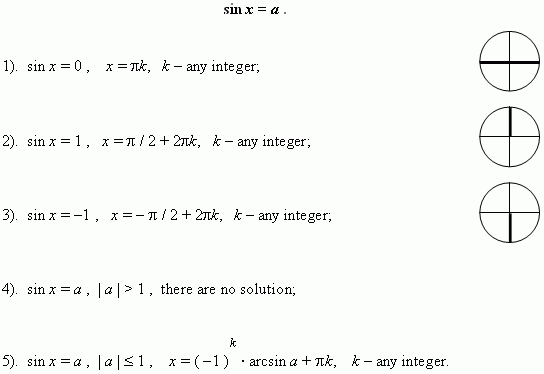


Methods for solving trigonometric equations. Solving of a trigonometric equation consists of the two stages: transforming of a equation to receive its simplest shape ( see above ) and solving of the received simplest trigonometric equation. There are seven main methods of solution of trigonometric equations.
1. Algebraic method. This method is well known for us from algebra ( exchange and
substitution method ).

2. Factoring. Consider this method by examples.
E x a m p l e 1. Solve the equation: sin x + cos x = 1 .
S o l u t i o n . Transfer all terms to the left:
sin x + cos x – 1 = 0 ,
transform and factor the left-hand side expression:

E x a m p l e 2. Solve the equation: cos² x + sin x · cos x = 1.
S o l u t i o n . cos ² x + sin x · cos x – sin ² x – cos ² x = 0 ,
sin x · cos x – sin ² x = 0 ,
sin x · ( cos x – sin x ) = 0 ,
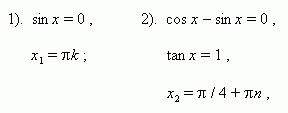
E x a m p l e 3. Solve the equation: cos 2x – cos 8x + cos 6x = 1.
S o l u t i o n . cos 2x + cos 6x = 1 + cos 8x ,
2 cos 4x cos 2x = 2 cos ² 4x ,
cos 4x · ( cos 2x – cos 4x ) = 0 ,
cos 4x · 2 sin 3x · sin x = 0 ,
1). cos 4x = 0 , 2). sin 3x = 0 , 3). sin x = 0 ,

|
3. |
Reducing to a homogeneous equation. An equation is called a homogeneous equation in sin and cos, if and only if all its terms are of the same degree in sin and cos of the same angle. E x a m p l e . Solve the equation: 3 sin ² x + 4 sin x · cos x + 5 cos ² x = 2. S o l u t i o n . 3 sin ² x + 4 sin x · cos x + 5 cos ² x = 2sin ² x + 2cos ² x , sin ² x + 4 sin x · cos x + 3 cos ² x = 0 , tan ² x + 4 tan x + 3 = 0 , hence y ² + 4y +3 = 0 , the roots of this equation are: y1 = –1 , y2 = –3 , from here 1) tan x = –1, 2) tan x = –3, |
4. Transition to a half-angle. Consider this method by the example:
E x a m p l e . Solve the equation: 3 sin x – 5 cos x = 7.
S o l u t i o n . 6 sin ( x / 2 ) · cos ( x / 2 ) – 5 cos ² ( x / 2 ) + 5 sin ² ( x / 2 ) =
= 7 sin ² ( x / 2 ) + 7 cos ² ( x / 2 ) ,
2 sin ² ( x / 2 ) – 6 sin ( x / 2 ) · cos ( x / 2 ) + 12 cos ² ( x / 2 ) = 0 ,
tan ² ( x / 2 ) – 3 tan ( x / 2 ) + 6 = 0 ,
. . . . . . . . . .
5. Introducing an auxiliary angle. Consider an equation of the shape:
a sin x + b cos x = c ,
where a, b, c – coefficients; x – an unknown.

New coefficients in the left-hand side have the properties of sine and cosine: a modulus
( absolute value ) of each of them is not more than 1, and a sum of their squares is equal
to 1. So, we can mark them as cos φ and sin φ correspondingly; here  is the so called
is the so called
an auxiliary angle.
Now our equation has the shape:
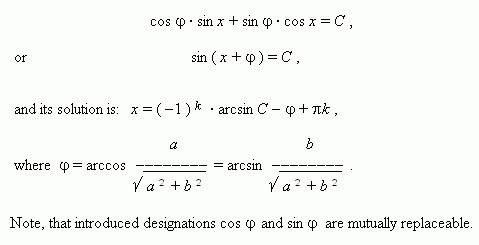
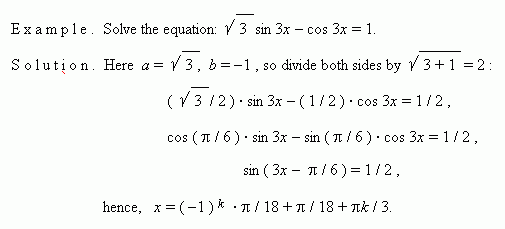
6. Transforming a product to a sum. The corresponding formulas are used here.
E x a m p l e . Solve the equation: 2 sin 2x · sin 6x = cos 4x.
S o l u t i o n . Transform the left-hand side to the sum:
cos 4x – cos 8x = cos 4x ,
cos 8x = 0 ,

7. Universal substitution. Consider this method by example.
E x a m p l e . Solve the equation: 3 sin x – 4 cos x = 3 .
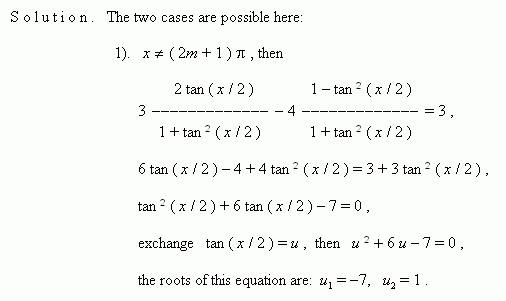
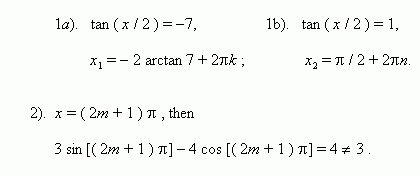
So, only the first case gives the solution.
 الاكثر قراءة في المثلثات
الاكثر قراءة في المثلثات
 اخر الاخبار
اخر الاخبار
اخبار العتبة العباسية المقدسة

الآخبار الصحية
















 قسم الشؤون الفكرية يصدر كتاباً يوثق تاريخ السدانة في العتبة العباسية المقدسة
قسم الشؤون الفكرية يصدر كتاباً يوثق تاريخ السدانة في العتبة العباسية المقدسة "المهمة".. إصدار قصصي يوثّق القصص الفائزة في مسابقة فتوى الدفاع المقدسة للقصة القصيرة
"المهمة".. إصدار قصصي يوثّق القصص الفائزة في مسابقة فتوى الدفاع المقدسة للقصة القصيرة (نوافذ).. إصدار أدبي يوثق القصص الفائزة في مسابقة الإمام العسكري (عليه السلام)
(نوافذ).. إصدار أدبي يوثق القصص الفائزة في مسابقة الإمام العسكري (عليه السلام)


















